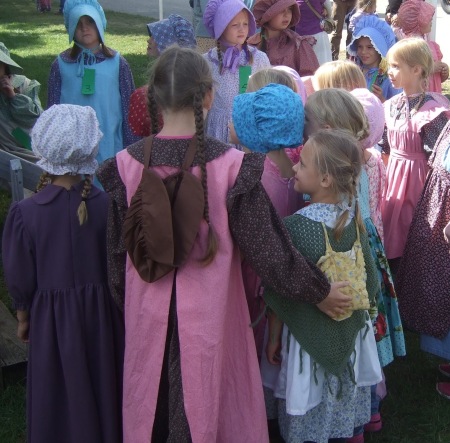I’m delighted to welcome my talented friend Linda Halpin to the blog! Linda is a quilt instructor and historian—and a Laura Ingalls Wilder fan.
* * *
Like many, my adventure with Laura started in grade school when I was captivated by her stories. This was long before television brought her to life. She lived in my head, made real by her story telling. As a child, I too began sewing at an early age, so whenever Laura mentioned sewing, it struck a chord. I remember her telling of how Ma expected her to do her job over until it was done well.
That pesky Bear’s Track quilt block she was making in On The Banks of Plum Creek, with so many bias edges that had to be done over and over until it was right.
The Doves in the Window quilt she made as a little girl that she packed into her trunk in These Happy Golden Years as she gathered belongings for her new life as Almanzo’s wife.
And it all started with the Nine Patch blocks she and Mary learned their sewing skills on. What were these patterns? What did they look like?
Fast forward many years: I had become a quilt teacher, leading classes for quilt shops and guilds across the country. One day, a young mom came into a shop where I was teaching. She was looking for a book that had patterns that tied in with the Little House stories. They were her daughter’s favorite books, and she wanted to teach her daughter how to quilt. What better way than to do it through quilt blocks that told Laura’s story?
Why hadn’t I thought of it before? It was the perfect project for me to undertake. I began with re-reading the entire Little House series of books, this time making note of all the times Laura mentioned quilts and fabric and sewing. Imagine my surprise to find over 70 references! Stitching truly was a part of her every day life.
As I made note of the patterns Laura mentioned, her adventures also brought to mind several quilt blocks that would be perfect to help tell her story: Log Cabin, Schoolhouse, Trail of the Covered Wagon.
By the time I was done, I had gathered 14 patterns that I thought would be perfect as a teaching tool that linked quilting and Little House. Quilting with Laura: Patterns Inspired by the “Little House On The Prairie” Series was published in 1991, with revisions and reprinting in 2015.
It has been the perfect way to tell Laura’s story in fabrics, picking and choosing the block designs most appealing to the maker.
* * *
Here are some of the quilts Linda has made to show how the individual block patterns in her book can be put together in different ways.

Andover Fabrics has twice invited Linda to make a display quilt using their Little House on the Prairie-inspired line. The 2015 quilt is shown at the top of the page; this one was created in 2016.
* * *
Linda Halpin has been teaching quiltmaking across the United States and Canada for over 40 year. She is one of a handful of teachers certified by the Embroiderer’s Guild of America as a Quiltmaking Instructor. In addition to Quilting with Laura, which focuses on hand piecing, the way Laura would have done, she has also written several other quiltmaking books as well as The Little House Sampler pattern, which is geared toward today’s machine piecing techniques. She was invited both in 2015 and 2016 by Andover Fabrics of New York to make quilts for them using their Little House on the Prairie inspired lines of fabrics, available in quilt shops nationwide. To see more of Linda’s work, or to learn about the classes and lectures she offers, visit her website at www.lindahalpin.com
* * *
Next time, Linda will share how she came to create a quilt for my Chloe Ellefson mystery, Death on the Prairie!





































